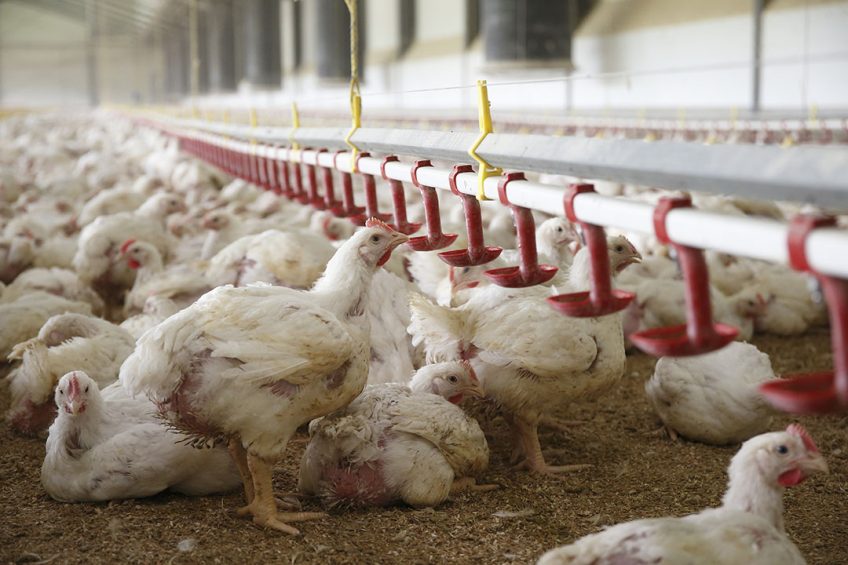Efficacy of berberine against mycotoxins in broiler diets

A new study published in Poultry Science found that berberine, a plant alkaloid, reduces the toxic effects of aflatoxins and ochratoxins in broiler diets.
A standard method used to control mycotoxins is the use of non–nutritive absorbing materials in the diet that bind the mycotoxins and reduce their uptake from the GIT. Several such binding compounds have been used with success. On the other hand, there is increasing emphasis on the use of plant extracts to reduce the toxic effects of mycotoxins. Berberine is a plant alkaloid with a long history of use in traditional Chinese and Indian medicine. This alkaloid is found in the roots, rhizomes, and shoots of many plants, including Coptis chinesis and Berberis vulgaris. Among other activities, berberine has strong antioxidant and anti-inflammatory properties.
The study
In this study, published in Poultry Science (2021), researchers induced experimental aflatoxicosis and ochratoxicosis by contaminating broiler feed with aflatoxins and ochratoxins to determine the efficacy of different levels of the plant alkaloid ‘berberine’ in reducing the effects of acute aflatoxicosis and ochratoxicosis on performance, antioxidant status, liver function, and gut function in broilers.
A total of 288-day-old chicks were used in this study, both mycotoxins were included at 2 ppm and the study consisted of 9 dietary groups as follows:
- NC: Negative control (no mycotoxin, no additives)
- AFB: NC + AFB (Aflatoxin; 2 ppm)
- OTA: NC + OTA (Ochratoxin; 2 ppm)
- AFB + BBR: NC + AFB + BBR (Berberine at three levels: 200 mg, 400 mg & 600 mg/kg)
- OTA + BBR: NC + OTA + BBR (Berberine at three levels: 200 mg, 400 mg & 600 mg/kg)
Performance of broiler chicks
The study showed that there was a reduction in feed intake and weight gain, and high FCR in the diets fed with mycotoxins (Table 1).
The FCR of chicks fed the NC diet was significantly lower compared to the FCR of chicks fed positive control diets contaminated with AFB and OTA. All the performance parameters were improved with the addition of berberine, in a dose-dependent manner. Mortality was also reduced by the addition of berberine. The reduction in performance was attributed to the mycotoxins’ inhibitory effects on secretion of digestive enzymes (damage to the digestive tract and liver), leading to impaired nutrient absorption and utilisation.
Berberine minimises the impact of mycotoxins
It was observed that berberine minimises the impact of mycotoxins through various mechanisms. For example, activation of B-cell lymphoma 2 family of conserved proteins, which inhibit mitochondrial permeability and release of apoptosis proteins from the mitochondria, ultimately inhibiting apoptosis or necrosis. The improvement in production and the reduction in the mortality rate was also attributed to the plant extract’s antioxidant and antimicrobial effects that inhibit pathogenic and non-beneficial GIT microbes.
Antioxidant status
The toxic effect of mycotoxins can lead to oxidative stress and the generation of free radicals, damaging the antioxidant system. In this study, adding berberine to the contaminated diets led to antioxidant effects, observed by a reduction of malondialdehyde, an end-product of lipid peroxidation that increases during oxidative stress and an essential indicator of antioxidant ability.
Another observation made was that berberine increases the production of antioxidant enzymes ‘superoxide dismutase’ and ‘glutathione peroxidase’, which compose a primary system that counters the toxic effects of free radicals. The researchers emphasised the fact that the degree of oxidative stress is related to the mycotoxin’s duration of contamination, co-contamination, the synergetic effects, toxin levels, and animal age, species and productive stage.
Liver function
In this study, changes in the liver of chickens fed the AFB and OTA diets indicated liver degeneration, which was seen as cellular swelling in hepatocytes, fatty degeneration, and vascular changes leading to liver enlargement. The damage to the liver was also seen through elevated levels of serum ALT, serum AST, and alkaline phosphatase, which are all indicative of degenerative changes in liver tissue. The addition of BBR at all levels resulted in both weight and lesion scores decreasing in a dose-dependent manner (Table 2). Knowing that these mycotoxins can induce apoptosis through inflammatory mechanisms and oxidative stress, it was speculated that the anti-inflammatory activity of BBR was able to reduce lesions caused by aflatoxin by reducing inflammatory cytokine production (which was observed in a previous study). It was concluded that berberine can ameliorate the effects of liver damage caused by aflatoxins and ochratoxins.
Gut function
The villus height, villus width and crypt depth decreased in broilers fed diets infused with AFB or OTA mycotoxins. All levels of berberine supplement improved these intestinal measurements. The ameliorating effect of berberine was attributed to its ability to reduce oxidative stress, reduce inflammatory factors, and regulate GIT microbiota, promoting the growth of epithelial cells.
Recommended level
It was concluded that berberine supplementation is a useful dietary strategy to prevent the effects of aflatoxicosis and ochratoxicosis in broiler chickens. Overall, berberine supplementation at 600 mg/kg was recommended as it improves growth performance, liver function, gut function, and the antioxidant status of broilers fed diets contaminated with aflatoxin and ochratoxin mycotoxins.











